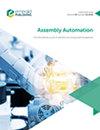Learning impedance regulation skills for robot belt grinding from human demonstrations
IF 1.7
4区 计算机科学
Q3 AUTOMATION & CONTROL SYSTEMS
引用次数: 5
Abstract
The purpose of this paper is to transfer the impedance regulation of manual belt grinding to robot belt grinding control.,This paper presents a novel methodology for transmitting human impedance regulation skills to robot control in robot belt grinding. First, according to the human grinding experimental data, the skilled worker’s arm impedance regulation is calculated. Next, the human skills are encapsulated as the statistical learning model where the kernel parameters are learned from the demonstration data by Gaussian process regression (GPR) algorithms. The desired profiles of robot are generated by the task planner based on the learned skill knowledge model. Lastly, the learned skill knowledge model is integrated with an adaptive hybrid position-force controller over the trajectory and force of end-effector in robot belt grinding task.,Manual grinding skills are represented and transferred to robot belt grinding for higher grinding quality of the workpiece.,The impedance of the manual grinding is estimated by k-means++ algorithm at different grinding phases. Manual grinding skills (e.g. trajectory, impedance regulation) are represented and modeled by GMM and GPR algorithms. The desired trajectory, force and impedance of robot are generated by the planner based on the learned skills knowledge model. An adaptive hybrid position-force controller is designed based on learned skill knowledge model. This paper proposes a torque-tracking controller to suppress the vibration in robot belt grinding process.从人类演示中学习机器人皮带磨削的阻抗调节技能
本文的目的是将手动皮带磨削的阻抗调节转移到机器人皮带磨削控制中。,本文提出了一种在机器人皮带磨削中将人阻抗调节技能传递给机器人控制的新方法。首先,根据人体磨削实验数据,计算出熟练工人手臂阻抗的调节规律。接下来,将人类技能封装为统计学习模型,其中通过高斯过程回归(GPR)算法从演示数据中学习核参数。任务规划器基于所学习的技能知识模型生成机器人的期望轮廓。最后,将所学习的技能知识模型与自适应混合位置力控制器集成在机器人皮带磨削任务中末端执行器的轨迹和力上。,为了提高工件的磨削质量,将手动磨削技术表现出来并转移到机器人皮带磨削中。,采用k-means++算法对不同磨削阶段的手工磨削阻抗进行了估计。手动研磨技能(如轨迹、阻抗调节)由GMM和GPR算法表示和建模。规划器基于所学习的技能知识模型生成机器人所需的轨迹、力和阻抗。基于学习技能知识模型,设计了一种自适应混合位置力控制器。本文提出了一种转矩跟踪控制器来抑制机器人皮带磨削过程中的振动。
本文章由计算机程序翻译,如有差异,请以英文原文为准。
求助全文
约1分钟内获得全文
求助全文
来源期刊

Assembly Automation
工程技术-工程:制造
CiteScore
4.30
自引率
14.30%
发文量
51
审稿时长
3.3 months
期刊介绍:
Assembly Automation publishes peer reviewed research articles, technology reviews and specially commissioned case studies. Each issue includes high quality content covering all aspects of assembly technology and automation, and reflecting the most interesting and strategically important research and development activities from around the world. Because of this, readers can stay at the very forefront of industry developments.
All research articles undergo rigorous double-blind peer review, and the journal’s policy of not publishing work that has only been tested in simulation means that only the very best and most practical research articles are included. This ensures that the material that is published has real relevance and value for commercial manufacturing and research organizations.
 求助内容:
求助内容: 应助结果提醒方式:
应助结果提醒方式:


